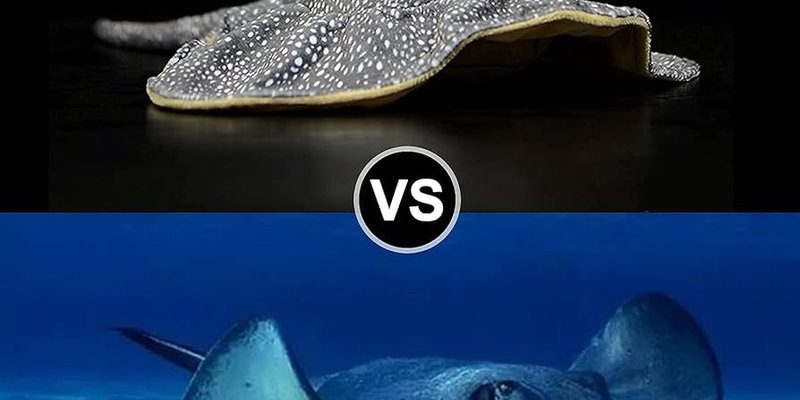![Stingray Vs. [Similar Species] - Key Differences](https://gudri.com/wp-content/uploads/2025/06/Stingray_Vs___Similar_Species______Key_Differences_image_0.jpg)
Both stingrays and skates belong to the same superclass called Elasmobranchii, which means they are cartilaginous fish. Their similarity can sometimes lead to confusion, especially for those new to marine life. But fear not! By exploring their distinct features, habitat preferences, and behaviors, we can better understand these captivating creatures. So grab your underwater goggles, and let’s explore the world of stingrays and skates together!
Physical Characteristics
When comparing stingrays and skates, the first thing you’ll notice is their shape. Both have flat, disc-like bodies, which helps them blend into sandy ocean floors. However, there are a few key physical differences to look out for.
Stingrays typically have a more streamlined, slender body and longer, whip-like tails. Their tails often come equipped with a venomous spine, which they can use for self-defense. Picture them like a superhero with a hidden weapon! These spines can deliver a painful sting, which is crucial for their survival in the ocean.
In contrast, skates have a broader body and shorter, thicker tails. They lack the venomous spines that stingrays possess, making them less intimidating. Instead, skates have small, bony structures called dermal denticles that give their skin a rough texture. This characteristic helps them camouflage against the ocean floor, which is essential for evading predators while they hunt for food.
Behavior and Habitat
As playful creatures of the sea, stingrays and skates also differ in their behavior and preferred habitats. Stingrays are often found in shallow coastal waters, where they can be seen swimming gracefully or resting on the seabed. They have a more adventurous spirit, occasionally diving deeper into the ocean or exploring new environments.
Skates, on the other hand, prefer to stay close to the bottom of the ocean. They tend to hide in sandy or muddy areas, using their flat bodies to stay concealed. This behavioral trait makes them a bit more elusive, quietly waiting for small fish, crustaceans, or mollusks to pass by before snatching their next meal. It’s almost like they’re playing a game of hide-and-seek with their prey!
Feeding Habits
When it comes to food, stingrays and skates have different hunting techniques and diets. Both species are carnivorous, but the way they catch their meals varies.
Stingrays use their flat bodies to bury themselves in the sand, blending in with the ocean floor. When unsuspecting prey, like small fish or invertebrates, swims by, they quickly strike, using their mouths to suck in the food. This ambush technique is highly effective, ensuring that they get the nutrients they need to thrive.
Skates, however, rely on their keen sense of smell to locate food. They typically scavenge the seabed for small organisms. Instead of ambushing, they often hunt at night, gliding along the ocean floor and using their powerful jaws to catch and crush prey. It’s like a late-night snack run under the sea!
Reproduction and Lifespan
Reproductive habits further differentiate stingrays from skates. Most stingray species are viviparous, meaning they give live birth to their young. After a gestation period of around 10 months, a mother stingray brings several pups into the world, which can swim away almost immediately. Imagine being a tiny stingray pup, swimming into the big ocean all on your own!
Skates take a different approach when it comes to reproduction. They are oviparous, which means they lay eggs. These eggs are often enclosed in protective cases, sometimes referred to as “mermaid’s purses” because of their unique shape. Once laid, the eggs are left to develop on their own, which can take several months depending on the species. This method provides a different kind of challenge for skates, as they rely on the safe environments of the ocean floor for their offspring’s survival.
Conservation Status
Both stingrays and skates face challenges in their natural habitats, but their conservation statuses vary. Many species of stingrays are considered vulnerable or endangered due to overfishing, habitat destruction, and bycatch in fishing practices. Their unique body structures make them more susceptible to being caught unintentionally, leading to population declines.
Skates, too, face threats, but some species are more resilient than others. However, like stingrays, they are affected by habitat loss and fishing practices. Conservation efforts are crucial for both species to ensure they continue to thrive in our oceans. It’s important to raise awareness about their ecological roles and promote sustainable practices to protect these incredible creatures.
Similarities in the Family Tree
Despite the differences, stingrays and skates do share some similarities. Both belong to the same class, Chondrichthyes, a group known for their cartilaginous skeletons. This unique anatomical feature provides flexibility, allowing them to navigate through their environments with ease.
Another shared characteristic is their flattened bodies, which help them avoid detection from both prey and predators. This common trait allows both species to thrive in similar habitats, although they utilize these spaces differently. Plus, both stingrays and skates have similar feeding mechanisms, allowing them to consume a diet rich in small marine creatures.
Final Thoughts
Stingrays and skates may look alike at first glance, but exploring their differences reveals how diverse and fascinating marine life can be. From their physical adaptations to their unique behaviors, these species play essential roles in ocean ecosystems. Understanding these differences not only enriches our knowledge of marine biology but also highlights the importance of conservation efforts.
So, the next time you spot one of these elegant creatures swimming by, remember the wonderful world they inhabit and the need to protect it. Dive deeper into marine conservation and keep advocating for the preservation of our oceans, ensuring these beautiful animals can continue gliding through the waters for generations to come!

